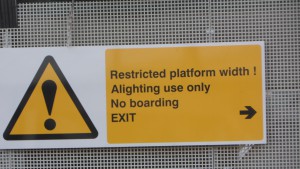PA announcements on the tube use the verb “alighting” for leaving the train. I know what the word means, but it sounds old-fashioned and formal to me (as a non-native speaker). Is it common parlance? E.g., if you had to give instructions to a close friend, would you say something like “Alight at xyz station”, or would you use a sloppier word (like “get off” or something similar) for this? Don’t need answer fast.
I find it hard to imagine anyone saying “Alight at xyz station” except , possibly, in some attempt at irony.
Officialese often tries to be more precise than common parlance, so I imagine that someone at TFL thought that “Alighting” sounded better than “getting off” or “leaving”.
No, ‘alight’ is not ‘common parlance’.
But railway announcements in the UK often have their own syntax, such as ‘where this train will terminate’, ‘mind the gap’, ‘apologies for any inconvenience caused’, and so on, none of which are really ‘common parlance’ .
(what gap? How should I ‘mind’ it?).
But over 200 years of railway travel (it is the bicentenary next year, 2025) these announcements have converged on a common form, with a certain amount of economy of words and meaning, and most people can understand them.
I would thank you for not using that kind of language outside the pit!
The (relatively recent) usage that irritates me is “our next station stop”.
Transport authorities have a formal language of their own. I once saw a notice on the Paris Metro which included the requirement that passengers should “obtempérer aux injonctions” of Metro staff (=“do as you’re told”).
I’d say it is standard british english, but rather old fashioned and not used much in everyday speech nowadays.
That one seems colloquial to me. If someone was following me and I had to step across a gap (like the classic situation in the curved Underground station) I could turn and say that while pointing down. And I’d use “mind” in other situations as a synonym for “be careful of”.
And now (give @Darren_Garrison’s link) I’m wondering if using “mind” like that would be understood in American as meaning “be careful of”?
We do have “mind your step,” to mean to be careful while stepping and (less commonly IME) “mind your head” to warn that a ceiling is low and you mind bump into it, so I never had any trouble understanding “mind the gap.”
Although “terminate” is not an everyday word, I’d certainly use it for the specific purpose of distinguishing the endpoint of a route from an intermediate stop. I can’t think of any other way of saying it.
“Should I stay on this train?”
“No, it terminates here.”
“End”, perhaps? Although I partially agree, I don’t find “terminate” in this instance particularly formal. Certainly less so than “alight”.
I’ve always hated that usage. The train does not terminate. The route does.
“The route terminates here”
“this is the terminus”
“this is the end of the line”
Prescriptivist claptrap.
ETA: a quick google - every dictionary definition I can find has the usage of a train/bus terminating, and none have the less common “the route terminates”. Colloquially I don’t think I’d even say “the route terminates” at all, I’d just say the “the route ends here”. There’s no ambiguity for a route. While a train can either make an intermediate stop or terminate, a route can only end.
The Toronto subway says “this is a terminal station” which is not a phrase I would use in casual conversation.
I think they also say “exit the train” (rather than “alight”).
I always assumed that was to avoid confusion, since “next station” could mean a station the train passes without stopping (and “next stop” could mean a stop the train makes between stations). Cf. The Goon Show:
Conductor: Where did you get on?
Seagoon: Curse, the game’s up. Well now, er… what was that last station?
Conductor: Fung Junction.
Seagoon: That’s it! That’s where I got on!
Conductor: But we didn’t stop there!
Seagoon: Do you think it was easy?
Also, “mind your manners.”
Yes, +1
Have you never seen an “alighting only” sign??


Don’t know if it is “common parlance”, but it appears on [the English text of] public transport signs all over the world.
I have never seen it in the US. And I’ve seen lots of places where public transit tried to separate those entering from those leaving, like the shuttle train at the Tampa airport.
Not true. A particular train can and frequently does terminate before the end of the line. If you want to continue your journey, you can transfer to a different one.
The gap:
https://citytransport.info/Digi/2946a.jpg
The Central Line stop at Bank is on a tight curve, resulting in a significant gap that could probably fit a small child.